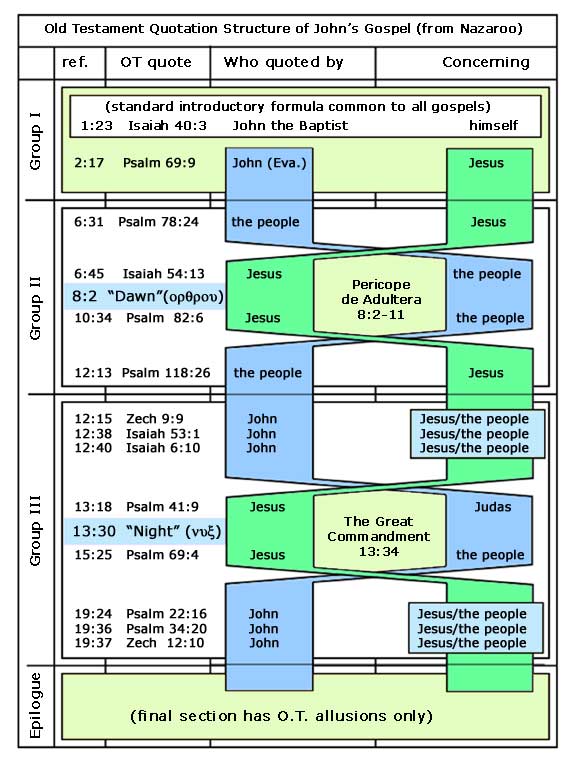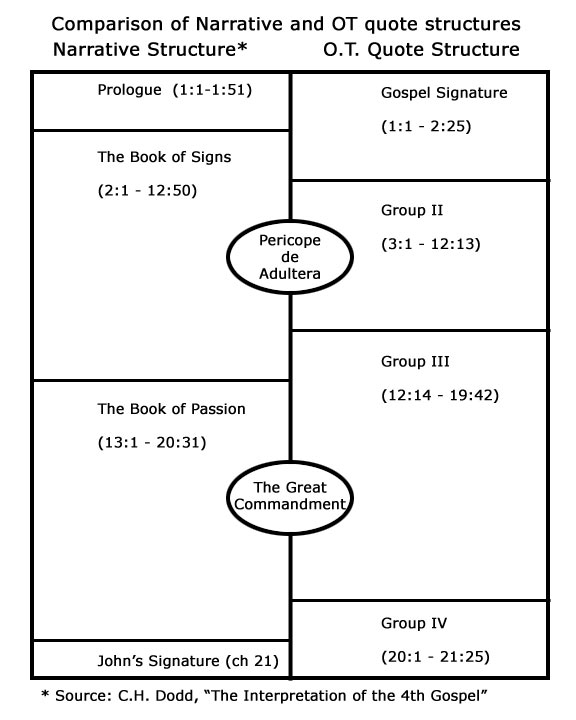O.T. Quotation Structure:
Introduction
O.T. Quotation Structure - what is it?
Everyone who has studied the Gospels has probably attempted to list all the O.T. references. The margins of most bibles offer a good head start. Yet one of the difficulties of trying to get a complete picture, is that sometimes an Evangelist will actually quote an easy to recognise OT scripture, but at other times will only vaguely allude to an OT scripture or event.
On the surface this toggling between quote and allusion appears random and unpredictable. Unfortunately, if we stop our investigation at this point, we will miss one of the most profound features of the Gospels. For it turns out that each Gospel writer had a pattern, a blueprint in mind when choosing to quote specific O.T. passages and pass over others of equal importance.
All four Gospel writers created elaborate structural patterns in their choice of quotations. These structures have deep meaning, for they collect and organise the incidents and speeches of the Gospel into great themes and logical sequences of development. If we miss these contexts and thematic associations, we also miss important clues as to the literary and didactic purpose of each Evangelist.
O.T. Quotation Structures - Meaning and Purpose
And yet for all its sophistication, the O.T. Quotation Structure embedded in each Gospel is a model of clarity and simplicity. We only need list the quotations in order, note who they are quoted by, and what they are quoted about, to see beautiful thematic patterns unfold. These patterns were not meant to be hidden, but rather discovered by those who truly seek truth and labour to discover it.
While this structural patterns serve a very important purpose in preventing or at least exposing severe tampering of the Gospels by the ignorant, we are convinced this was not their only purpose, or their main one. Instead, these structures were meant to be found and appreciated by Bible students everywhere.
O.T. Quotation Structure - John's Gospel
John's Gospel begins like all four canonical Gospels, with a standard introductory formula, Isaiah 40:3 (John 1:23). This is common to all the Synoptics, Matthew, Mark, and Luke as well. He compliments this with a quote from Psalm 69:9 (John 2:17) in the narrative/commentary.
After this, the Evangelist follows with a series of two chiastic patterns of quotations. These are like mirrors unfolding backward and forward from around a central core-point. It is a beautiful and quite common feature of John's Gospel in fact, which is virtually laced with smaller chiastic patterns throughout.
Each of these chiastic patterns centers around a critically important part of the Gospel, both in content and in evangelical/didactic theme. The first pattern centers around the Pericope de Adultera, obviously an important point in establishing its Sitz en Leben in the Gospel. The second pattern encircles the Great Commandment, which is presented in two developing forms, very close together.
Other complimentary and supplimental clues are provided by the Evangelist, such as the introduction of 'Dawn' and 'Night', symbolizing Light and Darkness, one of the many powerful themes coursing through John.
Without further ado, we present the majestic O.T. Quotation Structure for the Reader to view:

O.T. Quotation Structure - Critiques
The O.T. Quotation Structure we have discovered for the reader is not without its critics. We present an example of some of the more relevant complaints below:
(What follows is from an online thread in www.christianforums.com Dec.15/2005)
1. Group 1, The "Common Introductory Formula" --> probably a very poor choice of words since John begins entirely unlike the rest of the gospels. Moreover, in the other gospels it is the narrator who quotes the verse, not John himself.
2. Group 1, Ps. 69:9 [10] --> might as well be about Zeal as about Jesus. But I get your point.
3. 1:51 contains a conglomerated quote from Genesis.
4. Group 2, Ps. 78.24 is also a quote from Exodus 16. Also, the quotation is NOT about Jesus. Jesus replies it is about the Father, regardless of who/what the bread is meant to represent here.
5. Group 2, Ps. 82:6 -- not really about the people, is it?
6. Forgot John 12:27
7. 12:40 is about the people only, not Jesus.
8. 13.18 is about Judah/s and the disciples, not "the people."
9. 15.25 is about the people only, not Judas.
10. Again, "the people" is a hard case here -- "the people" in John is a special category. Here the phrase is about the soldiers...
11. 19.36,37 are about Jesus only, not the people.
Generally, it's a creative piece of work. But the methodology and conclusions are stretched and you display an ignorance -- whether of knowledge or by choice -- of the work that has previously been done on the structure of the Fourth Gospel. Moreover, structure in ancient texts is not marked the way you have attempted to do here -- and anyway your 'structure' is rather unwieldy in terms of regularity and symmetry.
O.T. Quotation Structure - A Brief Defence of its Existance and Purpose
FIrst to respond to some specific criticisms numbered above, we may note the following:
In regard to point (3), (6), we have already tried to underline the difference between true quotations and the softer 'allusions'. This distinction is what the whole O.T. Structure is based upon. It is a mistake by the critic here in understanding this subtle distinction. We don't deny the reality of the many O.T. allusions in John.
We confess there is a certain arbitrariness or 'net-casting' when trying to sum up the focus or target of some O.T. quotations (often rather complex prophecies). But this would be true of the lists of chapter or paragraph headings in any two bible versions. Each commentator will see things slightly differently, yet there is often extensive general agreement.
In the case of (4), obviously one's view of the role and nature of Jesus is involved. Part of the 'double-image' John creates is deliberate, and we would not want to be more insistent. But surely John 14:9 is adequate counter-balance to the critic's complaint in (4).
(8) and (9) are best taken together. The identification of Judas *with* 'the people' or rather as representing the people is a strong theme running throughout the Gospel and other Gospels as well. The naming of the betrayer 'Judah' can hardly be accidental, whether one takes the Spiritual 'synchronicity' view (prophecy fulfilled), or the critical view that these Gospels were artificially made political documents.
Generally speaking, we find more difficulty separating the roles of Judas and the people, the soldiers, and even the disciples (who abandoned Jesus) than the critic does. The reader can make up his own mind as to the various relations and connections, of which there are many in our view.
Our original response to this critique still stands, as far as we can see:
"I haven't displayed any ignorance of the work of redactional and form criticism of John, as far as I know.
This is just ONE MORE layer of structure built into the gospel, obviously unknown to you. It displays exactly the level of 'fuzziness' it should, given the author of John isn't going to reduce the prophetic fulfillments he has in mind just to make the hidden O.T. structure more symmetrical or sharper in definition. This would reduce the gospel to a repetative cartoon style of gospel, much like a sunday school coloring book.
By the way, contrary to your assertion, I have identified very clear O.T. structures in all four gospels and Acts. They were all laid out according to the plan of their respective authors/editors."
" ...But the methodology and conclusions are stretched and you display an ignorance -- whether of knowledge or by choice -- of the work that has previously been done on the structure of the Fourth Gospel. "
...just to pick up on this and clarify:
I have here a chart showing the complimentarity as opposed to conflict of the two known structural systems:
(1) The Narrative Structure identified by C.H. Dodd in his classic "The Interpretation of the Fourth Gospel", and
(2) The hitherto unobserved O.T. Quotation Structure in John discovered by yours truly.

...and to clarify further what this last chart is: It is a combination of Dodd's Outline on the left, and my O.T. Quotation structure on the right. I am not claiming that Dodd knew of the O.T. Quotation structure or that he somehow created this chart. I only made this chart for comparison purposes.